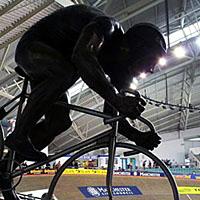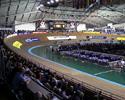
Recently on Cyclingnews.com |
Tales from the peloton, April 1, 2008
Reg Harris – a great British sprinter
Reg Harris was one of Britain's finest sprinters. Les Woodland looks back on his rivalry with Dutchman Arie van Vliet.

|
"In those days," Reg Harris said, "the rules of amateurism were so strict that you only had to mention that you were thinking of turning professional and they would declare you professional anyway." It was 60 years ago this year that Britain's greatest ever sprinter – in close sequence – smashed his ribs and back in a car crash, broke his elbow in a cycling crash, won two silver medals in the London Olympics, came third in the world championship, turned professional and won the world championship.
Harris stayed a hero long after he stopped racing but the air of pipe–puffing country gentleman that he affected was as false as his claim to be an amateur. One reason British cycling bigwigs were so keen to make him a pro was that by the London Olympics he was as good as a pro anyway, being employed and equipped by a colourful bike–maker called Claud Butler. He was also named in Russell Mockridge's book as one of the riders who kept their career going so long by popping the occasional pill.
I also remember an adage of his post–racing years: "Never trust your wife or your business to Reg Harris." Reg had three of the first and several of the other. None of that, though, makes him much different from a lot of other top bikies. What makes Harris different is that his life was so colourful, right from the day when he was the only survivor of a blazing tank. The army ruled him unfit for service but Harris knew better and the following year won three national championships.
Harris died in 1992, riding his bike near his home in north–west England. It was there that I met him, a hideaway cottage with stables, peaceful gardens and a prominent high–powered car. "I still get occasional letters from Germany and other parts of the world, asking for signed photographs," he said. And he smiled as he recalled that decades after his best years he still got the best seats in restaurants when Italian waiters recognised he'd once raced in their home town.
"I rode races," he said, "with a single–minded outlook, and that was to win. And I didn't take it very well when I was beaten." He bore grudges, he confessed. His biggest row was with Arie van Vliet, a Dutchman with a long, bony face and the air of a boffin. Harris, for all his genteel manners, came from a mill family and – until he chose to change it – spoke with an accent that could drop pigeons from the sky. Van Vliet, by contrast, was from a prosperous business family and van Vliet had no intention of working anywhere else until his brother persuaded him. The following year, van Vliet was Olympic kilometre champion.
"Yes, he was," Harris said, trying to hide that grudge. "But then, he hadn't been out in a cape and a sou'wester and ridden in the rain for eight hours." In other words, van Vliet was a soft kid from a well–off family and had never worked for a living on or off the bike. Not in the rain, anyway. The rivalry between the two provided both with a good living in the years when track sprinting was the élite of cycling. And then they fell out.
In the early 1950s, the world championships were in Paris. Harris and van Vliet were there and so was an unknown Briton called Cyril Bardsley. There were three in each race. The Dutchman looked at this – to him – insignificant Brit and asked Harris to make arrangements. "He could maybe lead me out in the sprint?" he suggested. Harris not only declined but went to Bardsley and explained all van Vliet's weaknesses. "The heat was being run and Bardsley for himself shut in. Van Vliet was in third position and he knew he couldn't stay there. And he shut down on Bardsley, who collected two or three broken spokes in his front wheel."
Harris insisted that he protest. "I said 'Show your wheel to the chief judge and make a case that it was before the 200-metre mark.' It was just about on it, but it could have been two or three metres before it or after it." The officials, in fact, supported van Vliet but the Dutchman was so furious that a long friendship with Harris ended there and then. And van Vliet exacted his revenge.

|
Harris, van Vliet and a Swiss rider, Oscar Plattner, were all up together with another world championship at stake. "And they fixed me up," Harris said. "Plattner drew number one and crawled away from the start at the bottom of the track. Van Vliet moved into second place, going even slower, and Plattner was opening up a gap because of van Vliet, which put me very close to van Vliet's back wheel. And so close to his wheel that I couldn't move around van Vliet to move into second position.
"Then Plattner put his head down and took off. I couldn't go around van Vliet because I was too slow. The moment I moved round him, I would have slipped over because of the 45–degree banking. By the time we got to the end of the first banking and I could get away from him, Plattner was probably 40 metres ahead and going for the lick of his life. And so I did the only thing I could do, which was to chase, and I chased for half a lap and swung up for van Vliet to come past and continue, if only for the public. But he swung out with me, and I knew then that I was fixed up.
"The following Thursday, there was an enormous revenge match that always took place in Amsterdam, with 5,000 spectators. Normally I'd share a large dressing room with van Vliet, but I went and got in with some of the other lads in their dressing room. And I happened to see Arie in the riders' quarters and he said 'What's wrong with my dressing room? Isn't it big enough tonight?'
"And I said, 'No, it never will be again for the two of us.' And that was the start of an enormous bloody war. We were bitter enemies. I mean, even that night, my wife and I were staying at his home – previously arranged – and my wife was sitting with his wife and his two teenage sons were there and they were in tears – 'What's happened to Daddy?' – and we didn't have a friendly word. And every time Arie said 'Look, isn't it time this was over?', I'd say 'It'll never be over so far as I'm concerned.'
"It got that way that some of the other riders were saying 'When are you two going to shake hands?', because life was getting bloody tough every time we were engaged anywhere. There was crossfire and the other guys were getting caught in it." In the end, the anger couldn't last. It burned out after 15 months and the pair became grudging colleagues if not friends. "I've seen him two or three times in recent years," Harris said. "If I've been over in Holland, I'd give Arie a ring and we'd chat for perhaps an hour on the phone."
It's finished now as a big attraction, of course, sprinting. No more do huge crowds file into velodromes to see huge–thighed men they recognise as gods and legends. A shame in a way, but then all things change. Even Harris's anger. Although right to the end, the grudge lived on.
What happened to the cast? Well, Cyril Bardsley realised he was never going to make it to top level and he opened a bike shop in Manchester. It's called Will's Cycles these days but the owners admit that locals still refer to it as Bardsley's. Arie van Vliet carried on riding until he was 41, that year even riding the world championship. His wife died in January 2001 and van Vliet died the following July, aged 85. Harris married three times, had trouble settling down after racing, worked as a salesman ("The name does open doors, yes...") , ran a bike factory that failed and had a brief and money–losing spell as owner of Manchester's outdoor track at Fallowfield. In 1974 he came back to racing and won the national professional championship. He died when he was 72 and his statue stands at the final bend of Manchester's indoor track.
A velodrome he didn't live to see. It opened, just a ride from his house, two years after he died.
Photography
For a thumbnail gallery of these images, click here
Images by Ben Atkins/Cyclingnews.com
- The Manchester velodrome
- Reg Harris is memorised in Manchester with this statue
